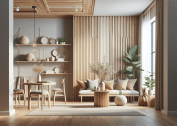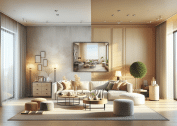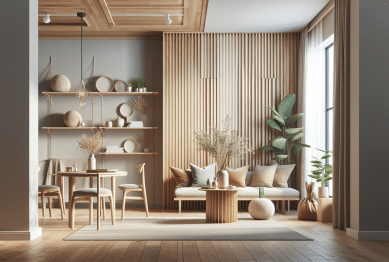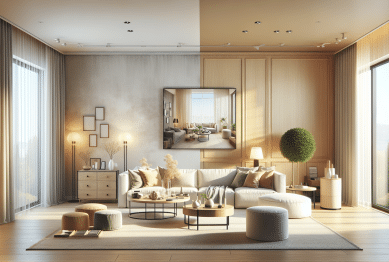Uncover practical strategies for transforming living spaces into peaceful home sanctuaries. Discover how interior styling, mindful decor, and stress-relief design features can foster relaxation, wellness, and genuine comfort in everyday environments.
Designing Spaces That Spark Calm
Curating a living environment that reflects serenity isn’t about complex renovations or expensive furnishings. Rather, small design changes can shift the mood and functionality of a home almost instantly. A calm space often starts with mindful arrangement, strategic use of soothing colors, and minimizing clutter. When the everyday environment feels inviting, it encourages unwinding after long days, supporting personal wellbeing. Layering calming textures—in linens, throws, or rugs—also adds softness, while delicate scents like lavender or vanilla further enhance relaxation. These subtle touches are deeply personal and invite you to enjoy moments of quiet comfort at any hour.
Natural light plays a transformative role in home sanctuary design. Allowing sunlight to pour in not only brightens rooms but also boosts mood and helps regulate circadian rhythms. Sheer curtains can maximize brightness while maintaining privacy, and mirrors placed opposite windows amplify the sense of openness. Research reveals that homes flooded with daylight can reduce stress and even support better sleep patterns. Reflecting this knowledge, many people look for ways to match room functions with lighting needs, ensuring that spaces for rest and work each have the optimal setup.
Choosing the right colors is like developing a personal palette for peace. Shades like pale blues, greens, and soft earth tones are known to have a calming effect and can help make busy or overstimulating spaces feel restful. Contrastingly, splashes of energetic color can be reserved for activity-dense zones like home offices or fitness corners. Making thoughtful color choices for each room’s purpose is essential in building a balanced environment. Adding natural elements, such as indoor plants or wood accents, grounds a space and connects it to the rhythms of the natural world.
Decluttering for Wellness and Clarity
Decluttering isn’t just a trend—it’s a conscious act that can directly affect your mental health. Studies suggest that cluttered environments increase stress hormones and reduce the ability to focus, while streamlined surroundings encourage clear thinking and relaxation. Beginning this process can be as simple as targeting the entryway or a single shelf. Letting go of unused items, obsolete electronics, or expired kitchen goods frees up physical space, and releases a subtle emotional weight. Infusing these habits with mindfulness—pausing to notice how each object makes you feel—can make tidying a gentle, positive ritual instead of a chore.
Organization systems add substantial value to peaceful home design. Designating a place for everything fosters tidiness and lowers the effort required to maintain equilibrium. For instance, baskets and labeled boxes keep busy areas orderly and ensure that essentials are always easily within reach. Wall hooks can manage outerwear or bags by the door, while vertical shelving creates new storage opportunities even in small apartments. As systems become routine, the results are visible: surfaces stay clear, and every item has a role, reducing daily friction and the accumulation of visual noise.
Digital decluttering is equally important in the journey to a tranquil home. Devices, cables, and glowing screens can create a subtle backdrop of tension. Setting up charging stations, keeping screen time in check, and establishing tech-free corners for reading or meditation offer a cue for the brain to shift from stimulation to relaxation. Many people also benefit from routine digital clean-ups—clearing old files, photos, or apps. This fosters not just a calmer home but also a clearer mental landscape.
Bringing Nature Indoors for Wellbeing
Biophilic design is more than a buzzword—it’s a movement backed by science. Connecting with nature, even indoors, can lower heart rates and blood pressure while boosting mood. Indoor plants are an easy and flexible addition, from low-maintenance succulents to air-purifying peace lilies. Many households enjoy selecting a variety of greenery that not only suits the light but also personal time for care. Pots in natural finishes—stone, clay, woven fibers—add warm, textured aesthetics. This approach turns corners and windowsills into peaceful, living displays.
Water features, such as tabletop fountains or small aquariums, introduce gentle movement and soft ambient sound. The presence of water has been linked to decreased cortisol, our primary stress hormone. If space permits, mini Zen gardens or simple vases of fresh flowers can provide similar effects. The act of nurturing even a single living plant or regularly changing a bouquet adds routine moments of mindfulness to bustling lives. This tangible sense of growth inside the home aligns beautifully with the concept of sanctuary—a retreat for renewal.
Naturally-inspired decor like wood paneling, stone tiles, or landscape art can evoke a grounding influence. Modern design often highlights large windows, garden access, or even balcony gardens for apartment dwellers. These features extend living spaces and support time spent outdoors, but even brief moments spent near a sunny window or with hands in a herb garden can imbue a sense of peace. Over time, these daily connections to nature become a crucial thread in the tapestry of home wellness.
Curating Zones for Mindful Living
Intentional zoning within the home carves out pockets for specific activities—rest, creativity, movement, or socializing. A nook for meditation, a reading corner with a plush armchair, or even a window seat surrounded by favorite books creates invitations to slow down. These defined areas support routine: a soft rug signals yoga time, while baskets of craft supplies encourage creative play. By shaping these micro-environments, it becomes easier to tune into the present moment.
Sensory mindfulness is woven throughout sanctuary design. The gentle hum of a diffuser, soft instrumental music, or the tactile pleasure of a favorite blanket all support relaxation. For many, building rituals—morning journaling at the kitchen table, or winding down with herbal tea by candlelight—turns ordinary actions into meaningful habit anchors. Minimizing overstimulation matters: dimmable lighting, noise-reducing curtains, and uncluttered surfaces offer respite from outside demands.
Flexibility in zoning is important as needs evolve. Combining a workspace and wellness corner, or adapting the dining area for both meals and family games, keeps the home reflective of its occupants’ lives. Simple folding screens or modular furniture make it possible to redefine boundaries without major expense or construction. This adaptability ensures that the home sanctuary is dynamic, welcoming both tranquility and joyful activity.
Personalizing Your Sanctuary with Creativity
Personal expression is at the heart of a sanctuary home. Displaying treasured artwork, family photos, or handcrafted objects adds layers of meaning. The process of curating these features can itself be meditative, allowing reflection on special moments and aspirations. Handmade decor, whether ceramics, pillows, or wall hangings, infuses spaces with warmth. These items aren’t just decorative—they’re reminders of experiences, achievements, and passions.
Color, pattern, and texture personalization fosters a unique sense of belonging. Whether it’s choosing patterned textiles reminiscent of childhood or painting an accent wall in a beloved hue, such touches reinforce emotional safety. While trends provide inspiration, the best choices reflect authentic tastes and lived experience. Open display shelves, gallery walls, or mood boards gather creative ideas in one place and can be changed as inspiration shifts with the seasons.
Comfort objects—such as favorite books, scented candles, or sentimental keepsakes—complete the sanctuary. Rotating cherished items keeps surroundings fresh and supports contentment with what is already owned. The joy of simply rearranging small treasures on a shelf or tabletop can turn a dreary day into an act of gratitude. Over time, these curated layers tell the unfolding story of the people who live there.
Cultivating Daily Habits for Lasting Tranquility
Maintaining a peaceful sanctuary is a daily practice, not a one-time event. Simple routines—opening windows for fresh air, making the bed, or lighting a morning candle—lay a foundation of order and intention. Studies show that daily rituals such as gentle tidying foster a mood of calm and increase feelings of agency. These actions signal the transition from busyness to relaxation, and vice versa, marking the rhythm of the day.
Mindful technology use also plays a key role. Creating periods of device-free time—in the bedroom, at meals, or before sleep—encourages presence and richer interactions. Many find value in scheduling short breaks just to pause and notice their surroundings or take a moment of deep breathing. Over time, these pauses become touchpoints of settledness, accessible even in challenging weeks.
Finally, reflecting regularly on what brings true comfort can inspire small adjustments tailored to evolving needs. Whether refreshing decor, rethinking layout, or evolving daily rituals, an ongoing connection to what nourishes the senses and the spirit keeps the sanctuary alive. This practice ensures that the home remains not just a place to live, but a continuous source of peace and renewal.
References
1. National Institutes of Health. (2021). Effects of clutter on mental health. Retrieved from https://www.ncbi.nlm.nih.gov/pmc/articles/PMC6696071/
2. Harvard Health Publishing. (2020). The power of natural light for health. Retrieved from https://www.health.harvard.edu/staying-healthy/light-for-good-health
3. Environmental Protection Agency. (2018). Indoor plants and air quality. Retrieved from https://www.epa.gov/indoor-air-quality-iaq/houseplants-indoor-air-quality
4. American Psychological Association. (2022). Mindfulness and home environments. Retrieved from https://www.apa.org/topics/mindfulness/home-environment
5. National Library of Medicine. (2020). Biophilic design and wellbeing. Retrieved from https://www.ncbi.nlm.nih.gov/pmc/articles/PMC6070359/
6. Sleep Foundation. (2023). The importance of sleep environments. Retrieved from https://www.sleepfoundation.org/bedroom-environment









